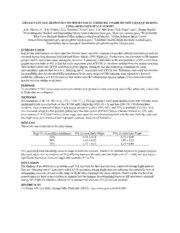
NASA Technical Reports Server (NTRS) 20110023176: Oxygen Uptake Responses to Submaximal Exercise Loads Do Not Change During Long-Duration Space Flight PDF
Preview NASA Technical Reports Server (NTRS) 20110023176: Oxygen Uptake Responses to Submaximal Exercise Loads Do Not Change During Long-Duration Space Flight
OXYGEN UPTAKE RESPONSES TO SUBMAXIMAL EXERCISE LOADS DO NOT CHANGE DURING LONG-DURATION SPACE FLIGHT A.D. Moore, Jr.,1 S.N. Evetts,2 A.H. Feiveson,3 S.M.C. Lee,1 F.A. McCleary,4 S.H. Platts3 and L. Ploutz-Snyder5 1Wyle Integrated Science and Engineering Group ([email protected], [email protected]), 2Wyle GmbH, ESA Crew Medical Support Office ([email protected]), 3NASA Johnson Space Center ([email protected], [email protected]), 4Lockheed Martin ([email protected]), 5Universities Space Research Association ([email protected]) INTRODUCTION In previous publications we have reported that the heart rate (HR) responses to graded submaximal exercise tests are elevated during long-duration International Space Station (ISS) flights [1]. Furthermore, the elevation in HR appears greater earlier, rather than later, during the missions. A potential confounder in the interpretation of HR results from graded exercise tests on ISS is that the cycle ergometer used (CEVIS) is vibration-isolated from the station structure. This feature causes the CEVIS assembly to sway slightly during its use and debriefing comments by some crewmembers indicate that there is a “learning curve” associated with CEVIS use. Therefore, one could not exclude the possibility that the elevated HRs experienced in the early stages of ISS missions were related to a lowered metabolic efficiency of CEVIS exercise that would raise the submaximal oxygen uptake (VO ) associated with 2 graded exercise testing work rates. PURPOSE To determine if VO values associated with submaximal graded exercise test work rates differ when early versus late 2 in flight data are compared. METHODS Six astronauts (3 M, 3 F: 48 ± 6 yr, 173 ± 7 cm, 77.1 ± 19.6 kg [mean ± SD]) participating in the ISS VO max study 2 performed cycle exercise tests on the CEVIS early (flight day (FD) 18 ± 3) and late (FD 150 ± 9) during their missions. Tests consisted of three 5-min stages designed to elicit 25%, 50%, and 75% of preflight VO max. VO 2 2 was measured using the ISS portable pulmonary function system (PPFS) (Damec, Odense, Denmark). VO data 2 from minutes 3–4 of each 5-min exercise stage were used for statistical comparison and the data from the early and late flight tests were analyzed with repeated-measures Analysis of Variance. RESULTS The results are contained in the table below. Stage (% of preflight maximum) VO (L/min) Early Flight VO (L/min) Late Flight 2 2 25% 0.78 ± 0.18 0.75 ± 0.09 50% 1.43 ± 0.33 1.45 ± 0.32 75% 2.15 ± 0.52 2.23 ± 0.60 VO increased with increasing exercise stage in both test sessions, which is the normal response to graded exercise. 2 However, there was no evidence of VO differing between the early and late flight tests (P = 0.60), nor was there a 2 significant interaction between stages and sessions (P = 0.27). DISCUSSION The finding of no differences in submaximal VO between the first and last tests conducted during flight indicate 2 that any “learning curve” associated with CEVIS occurring during flight does not influence the metabolic cost of submaximal exercise, at least in the range of flight dates examined for these subjects. Based on the results of the present analysis there is no evidence to suggest that the changes in submaximal exercise HR previously reported during ISS flight are related to alterations in submaximal exercise VO across test sessions. 2 REFERENCES [1] Moore AD, Lee SMC, Stenger MB, Platts SH. (2010). Acta Astronautica 66:974-998.
